If you’re running a B2B subscription business, you probably already have at least a few complex relationships between customers in your roster.
Maybe you have customers that are parent companies with various divisions, branches, or locations all using your service and generating transactions. Or perhaps some of your customers are resellers or have affiliate programs.
Managing subscription billing for these types of customer hierarchies gets pretty complicated.
- Payment methods need to be considered,
- subscriptions and purchases need to be combined, and
- then there’s the multi-jurisdiction taxation that needs to be updated and calculated on a recurring basis.
Oof.
All of this costs extra time and money for your business, and it can lead to less-than-ideal billing experiences for your customers.
Our team at Stax Bill is tuned in to the pain points subscription-based businesses face on a daily basis. And that’s why we built our customer hierarchy module to create smart, simple solutions to these complex requirements.
Let’s chat about five key ways the customer hierarchy module in Stax Bill’s recurring billing software adds simplicity, transparency, and optimization to your business’s subscription billing management process.
1. Easily establish hierarchical relationships between your subscription customers.
When your business has customers with parent-child-type relationships, you need to be able to establish those relationships clearly in your subscription management platform. Not only does this make things clear and efficient for your billing clerks, but also for other team members accessing your subscription accounts.
Any time you create a new customer in your Stax Bill platform, you have the option to assign them as a child to any company in your system.
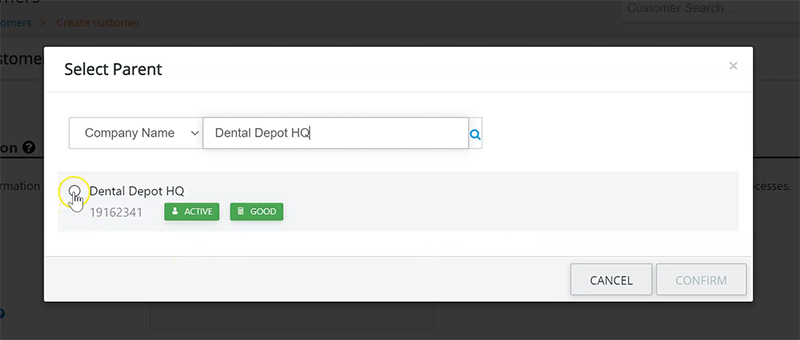
You can even create new child accounts directly from a parent account to streamline the process further.
From a parent account, you’re able to review and manage all associated child accounts from within the ‘children’ card—which you can see highlighted below.
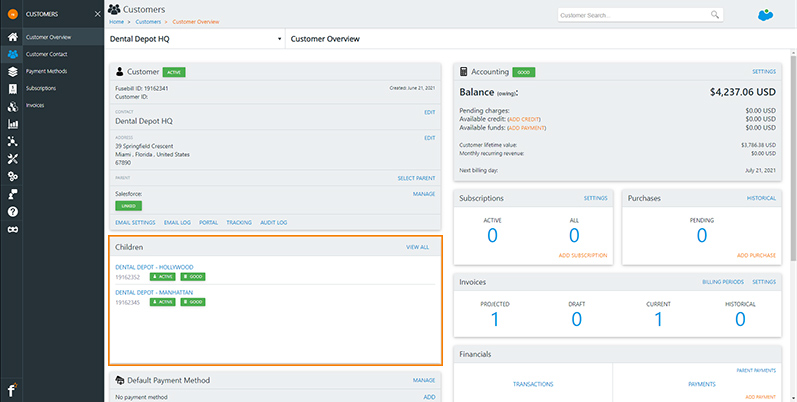
By selecting View All, you open a dedicated page for reviewing the parent’s child accounts—see below. From here, you can perform quick actions like managing their subscriptions and purchases, adding payments or credits, or disconnecting them completely from the parent’s account.
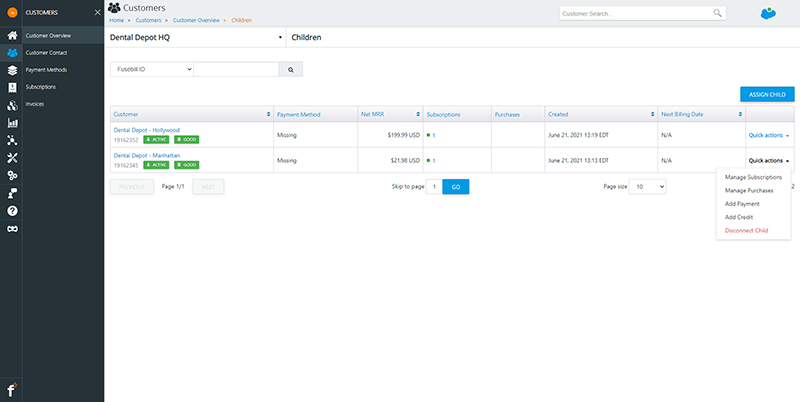
Finally, when it comes to transactions from recurring subscriptions and one-time purchases, anything activated on a child account gets pushed automatically to their parent.
As you can see below, while this parent customer has no active subscriptions or purchases of their own, they still show both a current and projected invoice.
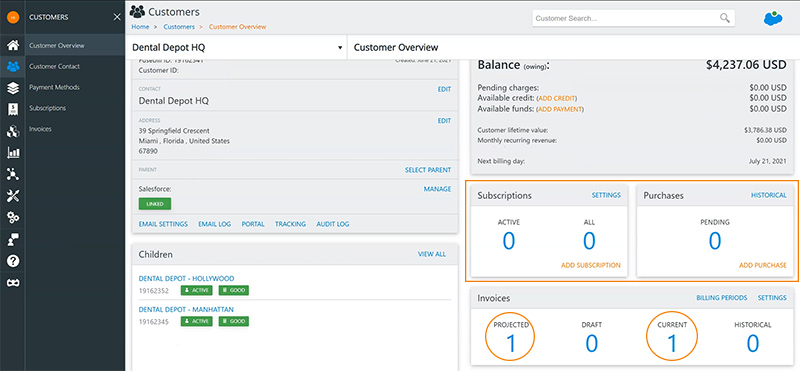
Again, the charges on these invoices have been pushed from their associated child accounts.
2. Automatically share payment methods within customer hierarchies.
When your business has hierarchies of customers, it also makes sense to be able to share a payment method from the parent account to the associate child accounts. Stax Bill gives you options here.
While a parent account’s payment method is automatically shared with all its associated child accounts, you can customize the process in the following ways:
- Choose to always use the parent’s payment method as the default method for child accounts.
- Choose to always use each child account’s own payment method as their default but have the parent’s payment method available to them.
- Force the billing clerk to make the decision on each transaction of whether the parent’s or the child’s payment method should be applied.
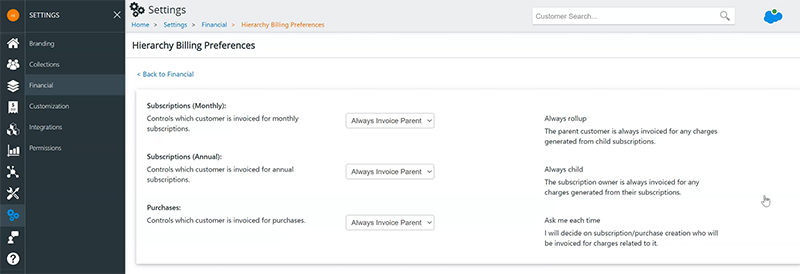
And as you can see above, you can make these customizations separately for monthly and annual subscriptions as well as purchases. All of this is critical to enable your business to have more control of how your customers are billed. It also enables you to tailor your customers’ billing experience based on their preferences of who gets billed and when.
3. Produce a single unified invoice.
When parent customer accounts are accumulating charges from their associated child customers, those charges all need to be brought together concisely.
As we touched on above, in Stax Bill, each time a subscription or purchase is activated on a child customer, that transaction is automatically placed on a single, unified pending invoice which will output on their parent customer’s account.
This means if the parent customer has multiple associated child customers, the unified invoice will contain transactions from all those children.
As you can see in the example below:
- Dental Depot HQ is the parent customer account being invoiced.
- It has two associated child accounts, or in this case, two branches generating charges: Dental Depot – Hollywood and Dental Depot – Manhattan.
- If the Dental Depot HQ had its own subscriptions and purchases, those would appear in a separate box above the child charges.
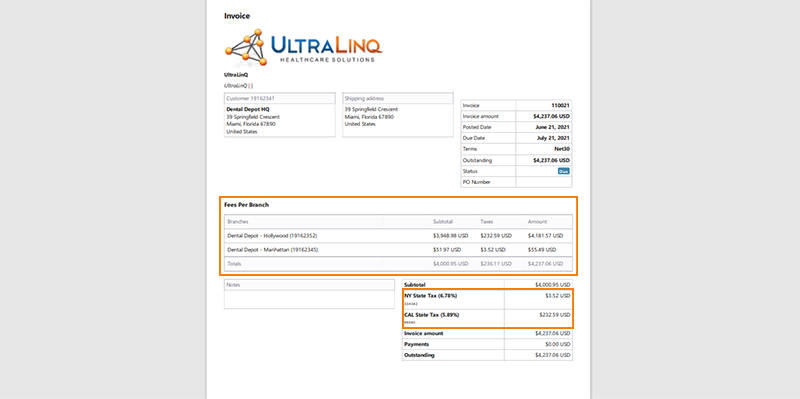
The unified invoice also takes care of the multi-jurisdiction taxation for this parent company. One of its branches is in New York, while the other is in California. Tax is calculated and applied for each and added to the total for the invoice.
Simple.
Taxes obviously vary from state to state and country to country. Improperly accounting for tax variations and changes over time can lead to revenue leakage for your business. Ensuring accuracy through automation is key as your business scales and expands geographically.
Another great benefit to the unified invoice? You reduce your payment processing fees.
- Because payment is processed only once per billing cycle on parent accounts, you can say goodbye to unnecessary gateway fees.
- Parent customers can also be enabled to add large lump-sum payments to their accounts and have their recurring invoice totals automatically reduced from that balance.
- This reduces hits to their payment method and reduces those gateway fees for your business even further.
4. Get customized with your hierarchical subscription billing process.
We’ve talked about some of the ways you might customize your hierarchy billing process. But let’s get into a few more.
How about your invoice?
You want it to use language and show details in your invoices that make sense to your customers. Having the ability to edit naming conventions and show or hide various details creates that better subscription billing experience.
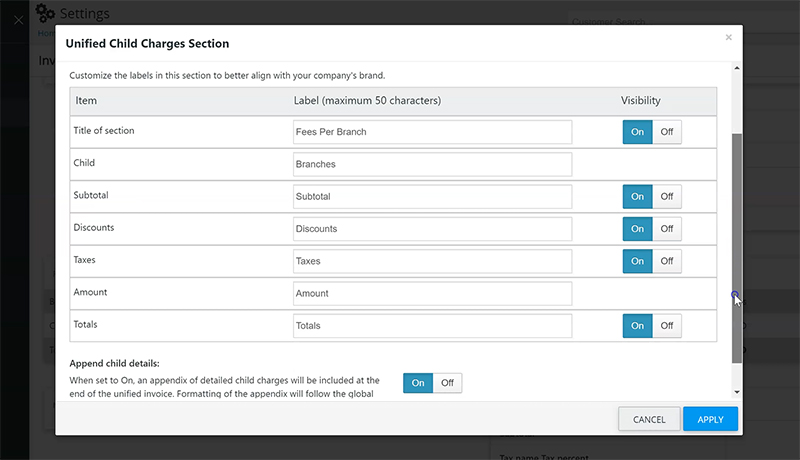
And while having all a parent customer’s child customer charges rolled into one invoice is useful, you might also want to show them even more details on each child customer’s individual charges.
Stax Bill enables you to append child details, which basically attaches an additional page to your main unified invoice for each child customer, as shown below.
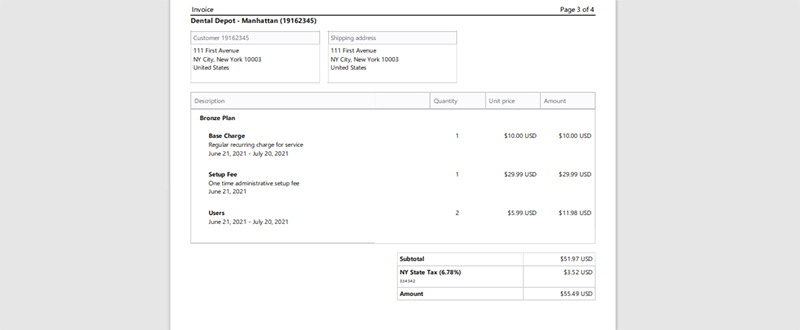
Not only does this make it easy to review all the details of a child customer’s charges, but it can also be helpful if some of your customers are resellers or have affiliate programs…
5. Provide full support for affiliate and reseller programs.
Appending separate child invoices to your unified invoice—like we just saw—can be an incredibly useful subscription billing management feature for businesses with reseller customers or those that have affiliate programs.
Why? Being able to parse out the individual invoices and charges makes it simple to reinvoice down the line—especially when accurate taxation for each of those invoices is already calculated for you.
It’s also useful to have flexibility when it comes to how your business chooses to set up its more complex affiliate and reseller programs. With Stax Bill, you can either:
- run all subscriptions under one customer entity, or
- distribute subscriptions across any number of child customers—attaching a sales tracking code to each sales customer.
The latter option provides your business with more comprehensive reporting in combination with still providing the unified invoice to the affiliate/reseller entity.
Flexibility to manage subscription billing for the most complex customer relationships
At the end of the day, having the flexibility to organize your various customer hierarchies and bill them in a way that makes sense for your business and your customers is a huge step toward optimization. Your team will have a clear and concise way to manage subscription billing for your more complicated customer relationships, and your customers will be billed transparently and accurately. Every. Single. Time.
Support for hierarchy-based subscription billing also opens new doors and creates simplicity when it comes to different business models and strategies, from reseller relationships to affiliate programs.
Our team at Stax Bill is continuing to build out our customer hierarchy module to solve your business’s pain points. Because greater flexibility makes it a whole lot easier for your business to scale without limitations.







